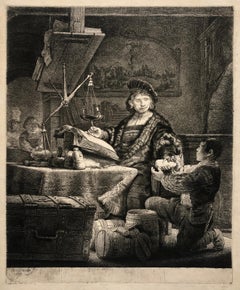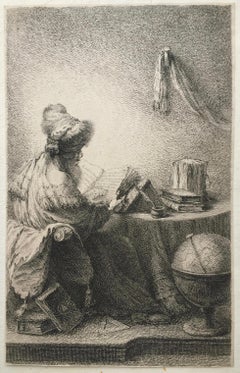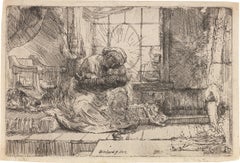Rembrandt van Rijn Interior Prints
Dutch, 1606-1669
Rembrandt was the most influential 17th Century Dutch painter. After years of early success as a portrait painter, his life was beset by financial hardship and personal tragedy. He continued to paint portraits and develop etchings. Rembrandt's portraits of his contemporaries, self-portraits and illustrations of scenes from the Bible are regarded as his greatest creative triumphs. His self-portraits form a unique and intimate autobiography, in which the artist surveyed himself without vanity and with the utmost sincerity. Like many artists of the Dutch Golden Age, such as Jan Vermeer of Delft, Rembrandt was also an avid art collector and dealer. Rembrandt never went abroad, but he was considerably influenced by the work of the Italian masters and Netherlandish artists who had studied in Italy, like Pieter Lastman, the Utrecht Caravaggists, Flemish Baroque, and Peter Paul Rubens. Rembrandt's foremost contribution in the history of printmaking was his transformation of the etching process from a relatively new reproductive technique into a true art form, along with Jacques Callot. His reputation as the greatest etcher in the history of the medium was established in his lifetime and never questioned since. Few of his paintings left the Dutch Republic while he lived, but his prints were circulated throughout Europe, and his wider reputation was initially based on them alone.(Biography provided by Lost Art Gallery)
to
3
2
1
1
2
Overall Height
to
Overall Width
to
3
3
3
2
2
1
3
35
89
86
74
51
2
1
1
Artist: Rembrandt van Rijn
Jews in the Synagogue
By Rembrandt van Rijn
Located in Boston, MA
Bartsch 126; Hind 234; Nowell-Usticke 304 v/VII. Signed and dated in the plate above the shoulder of the second man from the left (obscured by diagonal shading): "Rembrandt f. / 1648...
Category
17th Century Old Masters Rembrandt van Rijn Interior Prints
Materials
Etching
Jan Uytenbogaert, The Goldweigher
By Rembrandt van Rijn
Located in Boston, MA
Bartsch 281, Hind 167 iii/III, Nowell-Usticke 281, iii/III. A fine impression, with burr, as retouched by Baillie in 1792. With an unidentified collectors stamp, verso.
Category
17th Century Old Masters Rembrandt van Rijn Interior Prints
Materials
Drypoint, Etching
The Death of the Virgin
By Rembrandt van Rijn
Located in San Francisco, CA
A strong, dark 18th century impression of Bartsch's third and final state. Similar to that found in an impression of the same state in the collection of the Metropolitan Museum of Ar...
Category
18th Century and Earlier Old Masters Rembrandt van Rijn Interior Prints
Related Items
France at her Furnaces
By James McBey
Located in Storrs, CT
1917. Etching. Hardie 175. 8 x 15 (sheet 10 1/8 x 16 15/16). Edition 76. Slight mat line; otherwise excellent condition. A rich impression printed on antique laid paper with full m...
Category
1910s Modern Rembrandt van Rijn Interior Prints
Materials
Drypoint, Etching
(PHILOSOPHER READING)
By Ferdinand Bol
Located in Santa Monica, CA
Circle of or a follower of Ferdinand Bol - (1616-1680)
(PHILOSOPHER READING) ca 1700
Etching on thin laid paper attached to support sheet at the top sh...
Category
18th Century Old Masters Rembrandt van Rijn Interior Prints
Materials
Etching
Soup
By Edmund Blampied
Located in Storrs, CT
Soup. 1920. Drypoint. Appleby 65. 9 x 8 1/8 (sheet 15 x 11 9/16). Edition 100. Illlustrated: Print Collector's Quarterly 13 (1926): 85. Signed in pencil.
Edmund Blampied was a painter, etcher, lithographer and sculptor. Born in 1886 to a family of three boys in St. Martin, Jersey, Blampied became interested in drawing at an early age. After visiting the studio of John Helier Lander in 1899, Blampied decided to make a career as an artist. In 1903 he went to London to attend Lambeth Art School, where he studied etching under Walter Seymour.
In 1905, he joined the Daily Chronicle as an artist. In that year he was awarded a scholarship to Bolt Court Scool of Photo-engraving and Lithography.
In 1912 he left the Chronicle and established his own studio. He earned a living by illustrating novels and short stories.
In 1913, he had his first exhibition at the Leicester Gallery in London. The following year he married Marianne Van Abbé.
During the 1920's, he became a member of the Royal Society of Painter-Etchers and Engravers. During the 1920s Blampied became a member of the Royal Society of Painters-Etchers and Engravers and exhibited in London to critical acclaim. He produced a folio of comic drawings in the 1930s which was published in New York in 1934 and another that was published in London in 1936. The Keeper of Prints and Drawings at the British Museum published a mongraph on his work. His London exhibitions were highly successful.
In 1938, he moved to Bulwarks, St.Aubin in Jersey, but at the onset of the Occupation, had to relocate to Route Orange, St. Brelade. remained there throughout World War II during the German Occupation, despite the fact that his wife was Jewish. During the Occupation he designed bank...
Category
1920s Modern Rembrandt van Rijn Interior Prints
Materials
Drypoint, Etching
The Letter
By Edmund Blampied
Located in Storrs, CT
The Letter. 1921. Drypoint. Appleby 107. 7 x 9 3/8 (sheet 10 1/2 x 15 7/16). Edition 100. Illustrated: Fine Prints of the Year, 1925; Salaman, Modern Masters of Etching: Edmund Blamp...
Category
Early 20th Century Modern Rembrandt van Rijn Interior Prints
Materials
Drypoint, Etching
Vintage Le Corbusier '69 David Hockney Exhibition Poster Kilim southwest rug
By (after) David Hockney
Located in New York, NY
Shading in bright turquoise above a Southwestern style thunderbird Kilim rug adorns this original exhibition poster for David Hockney's 1969 show at Andre Emmerich, New York. This po...
Category
1960s Realist Rembrandt van Rijn Interior Prints
Materials
Lithograph
The Rest on the Flight into Egypt - engraving after Rembrandt - 19th Century
By Charles Amand Durand
Located in Roma, IT
The Rest on the Flight into Egypt is an engraving on ivory-colored paper realized after Rembrandt by Charles Amand Durand (1831-1905) after an etching by Rembrandt. This wonderful pi...
Category
19th Century Old Masters Rembrandt van Rijn Interior Prints
Materials
Engraving
H 4.34 in W 3.15 in D 0.04 in
Robert Combas Original Serigraphy Limited Edition Artist Proof hand signed
By Robert Combas
Located in Paris, FR
"Adultery", 1990
Large original serigraphy printed on fabric, very rare and limited Edition of 30 Artist Proof signed hand by the artist in black ink and accompanied by its certificate of authenticity.
Number: EA - 30 EA (30 Artist Proof )
Dimensions of the serigraphy : 140 x 140 cm
Very good condition.
Imposing and important highly illustrated monograph, with a lively layout, of one of the best-selling French artists on the international contemporary art market. A colorful and highly circumscribed painting, inspired by comics, graphics and popular art, and anchored in rock’n’roll imagery since 1977.
The art market confirms that Robert Combas is the most successful living French artist with Pierre Soulages.
During the last two years, the value of his works has multiplied by 5 , proof with the last Artcurial auction sale from December 4th 2019.
With its carefully surrounded black shapes, its faces out of a comic strip and its bright colors, this work which treats adultery with derision corresponds well to the criteria of Free Figuration, a movement, born in 1979, around this Lyonnais artist and and his cronies.
Casually appropriating advertising images, comics, science fiction as well as great works in the history of classical art, these artists break with the seriousness of the time. It is in Epinal style illustration and imagery that one must look for the missing link to understand the art of Combas.
Robert COMBAS has been pursuing a unique approach since the 1980s. His eccentric and powerful representations of the world make this genius one of the emblematic figures of French contemporary art.
The artist's work is now the subject of numerous retrospectives and institutional exhibitions. The enthusiasm of collectors becomes more important with each new public sale and its rating climbs which confirms the sustainable nature of the art of Robert COMBAS.
He brought at the dawn of the 80s a new figurative painting. Present on the artistic scene since 1979 he is the creator of a movement that the artist Ben called the Free Figuration, movement comprising: Rémi Blanchard...
Category
Late 20th Century Contemporary Rembrandt van Rijn Interior Prints
Materials
Fabric, Canvas
H 55.12 in W 55.12 in D 1.19 in
S. Paolo Fuori Le Mura (Vedute della Basilica di S. Paolo fuor della mura)
By Giovanni Battista Piranesi
Located in Fairlawn, OH
S. Paolo Fuori Le Mura (Vedute della Basilica di S. Paolo fuor della mura)
Etching, 1748
From...
Category
1740s Old Masters Rembrandt van Rijn Interior Prints
Materials
Etching
The So-Called Tempio della Tosse, Near Tivoli. Interior Upright
By Giovanni Battista Piranesi
Located in Fairlawn, OH
The So-Called Tempio della Tosse, Near Tivoli. Interior Upright (Veduta interna del Tempio della Tosse)
"Temple of the Cough"
Etching, 1764
Signed in the plate
From: Vedute di Roma...
Category
1760s Old Masters Rembrandt van Rijn Interior Prints
Materials
Etching
'Jesus and the Woman at the Well, ' by Amand-Durand, Engraving
By Armand Durand
Located in Oklahoma City, OK
This early 19th century framed 35" x 31" engraving by artist Amand-Durand depcits an etching of 'Jesus and the Woman at the Well,' after the Dutch master, Rembrandt van Rijn. This poignant Biblical story is depicted by Arman-Durand in Rembrandt style...
Category
Early 19th Century Old Masters Rembrandt van Rijn Interior Prints
Materials
Engraving
H 35 in W 31 in D 2.5 in
Sportsmen
By Louis Legrand
Located in Storrs, CT
Sportsmen. 1908. Etching and drypoint. Exsteens 271.i/ii. 11 1/4 x 5 3/4 (sheet 17 3/8 x 12 1/4). Series: Les Bars. From the first state edition of 30 proofs with the remarque sketch...
Category
Early 1900s Post-Impressionist Rembrandt van Rijn Interior Prints
Materials
Drypoint, Etching
18th Century Etching of Ancient Roman Architectural Objects by Giovanni Piranesi
By Giovanni Battista Piranesi
Located in Alamo, CA
A. Tigna Protensa Super Media Epistylia, B. Praecisiones Tigorum Quaqua Versus Extrinsectus Apparentium, C. Opae Extremitates Tigorum Contintes, Fig. I, plate 88 from "Vasi, Candelab...
Category
Mid-18th Century Old Masters Rembrandt van Rijn Interior Prints
Materials
Etching
H 29.63 in W 36.63 in D 1.25 in
Previously Available Items
The Virgin And Child With The Cat And The Snake By Rembrandt Van Rijn
By Rembrandt van Rijn
Located in New Orleans, LA
Rembrandt van Rijn
1606-1669 Dutch
The Virgin and Child with the Cat and the Snake
Etching laid on paper
New Hollstein's first state of IV
Signed and dated "Rembrandt. f. 1654" (u...
Category
17th Century Old Masters Rembrandt van Rijn Interior Prints
Materials
Etching, Laid Paper
H 20.25 in W 16.25 in D 0.75 in
Christ Driving the Money Changers from the Temple
By Rembrandt van Rijn
Located in Fairlawn, OH
Signed in the plate lower right
A rich impression printed with some burr and plate tone in the shadows of the figures to the right
Watermark: Ash & Fletcher, Arms of Amsterdam D.c. presumed after 1650
Thought to be a slightly posthumous impression, with alterations in the plate not by Rembrandt.
Reference: Hind 126 ii/II, Bartsch 69 ii/II, New Hollstein 139 ii/IV
Before the retouching of plate and the posthumous editions by Watelet, Basan and Bernard
Note: MMA has a similar impression ii/II that compares very closely with this impression as does the Achenbach Foundation at the Fine Arts Museums of San Francisco and the Morgan Library.
The National Gallery of Art, Washington has a superior impression of ii/II (as here) with selective inking to achieve dramatic painterly effect.
According to Clifford Ackley in Rembrandt’s Journey Painter Draftsman Etcher, MFA Boston,
“Christ Driving the Money Changer from the Temple is perhaps the most physically energetic episode in Christ’s ministry. Christ’s cleaning the place of worship of those who seek to profit from religion is recounted by all four evangelists (see for example, John 2:13-16. Jesus made himself a flail of rope and wielded it vigorously to drive from the temple the moneychangers and those who sold cattle, sheep and doves for sacrificial offerings. Overturning the tables of the moneychangers, he declares that “My house shall be called the House of Prayer, but ye have made it a Den of Theives” (Luke 19:46).
The figure of Christ is one of Rembrandt’s most blatant creative borrowings. It is a reverse copy of the figure of Christ from the Albrecht Durer print...
Category
17th Century Old Masters Rembrandt van Rijn Interior Prints
Materials
Etching
The Death of the Virgin - Original Etching by Rembrandt - 1639
By Rembrandt van Rijn
Located in Roma, IT
The Death of the Virgin is an etching with drypoint tweaks on wire rod double filigree paper, realized in 1639 by Rembrandt Harmenszoon van Rijn (Leiden, 1606 - Amsterdam, 1669).
Probable specimen of III state on three (according to White & Boon), IV on four (following Biörklund-Barnard).
Signature and date on plate on the lower left corner “Rembrandt f. 1639".
The paper has a cluster watermark with symmetrical elements in the center (similar to Ash Grapes B.a.) and a second watermark written on 4 lines (perhaps identifiable with Ash Words C.a.).
Superb specimen on doubly watermarked paper: the first on four lines dating back to around 1764 and widely diffused in Normandy and Germany; the second, clustered, traced back to the second decade of the 17th century. Sheet characterized by a legible and appreciable impression for the chiaroscuro; good conditions of conservation, even though some thinning is reported, in particular along the left margin and on the lower left corner, together with small gaps visible on the back and a superficial deposit of particles.
Reference:
Gersaint 1751, p. 71, n. 97; Bartsch 99; Hind 1924, n. 161; Biörklund-Barnard 1957, n. 39, IV; New Hollstein (Dutch & Flemish), n. 173 (Rembrandt); Hinterding et al. 2000 n. 32.III; White & Boon 1969, n. 99.III.
One of the most interesting works with a religious subject by the great old master, for both the compositional freedom and the technical expertise. We do not know who the customer was; it could have been a Catholic client, but this hypothesis seems to be at least doubtful precisely because of the peculiarity with which the episode is narrated. Certainly, this artwork is linked to a precise market request, given its size - this is the second largest incision of the artist - and the commitment to such an important work.
A more detailed description of this religious event is described particularly well in the Legenda Aurea by Jacopo da Varagine, a guiding text in the Middle Ages for all the artists who wanted to portray the Death of the Virgin: an angel appeared to Mary announcing her imminent death. It is told that the Apostles, dispersed in the four corners of the world to proclaim the Gospel, were miraculously transported to Mount Zion to be near them.
Disagreeing with other exegetes, Hinterding claims that Rembrandt knew the Legenda but was inspired by it in an original way, combining two moments in a single choral scene. Indeed, the scene depicted by the artist takes place in the bedroom of the Virgin: the angel appears at the top, accompanied by the cherubs, while the Apostles gather around her bed. For this marvelous etching, in addition to the aforementioned text by the Dominican friar da Varagine, Rembrandt certainly also looked at two fundamental works (to understand the genesis of the composition): the Death of the Virgin by Albrecht Dürer, from the silographic series of the Life of the Virgin, of which he owned a specimen, perhaps bought at auction in 1638, and a stained glass window designed by Dirck Pietersz Crabeth (1501-1574), in the Oude Kerk in Amsterdam. From Crabeth, he took the figure in the foreground that is reading the Holy Scriptures, perhaps the personification of the Church, and the canopy bed that stands out at the center of the scene. The young man with long hair described on the right, perhaps San Giovanni Evangelista, is instead a quotation from the Adoration of the Magi (1513) by Lucas Van Leyden, an artist much appreciated by Rembrandt. In Rembrandt's version of Mary's farewell, there are not only the Apostles: around her there are men and women, young and old, someone, intrigued, peeks out from behind the bed or a curtain, in the background, on the right, others pray kneeling...
Category
1630s Old Masters Rembrandt van Rijn Interior Prints
Materials
Etching
H 15.56 in W 12.41 in D 0.04 in
Rembrandt Van Rijn interior prints for sale on 1stDibs.
Find a wide variety of authentic Rembrandt van Rijn interior prints available for sale on 1stDibs. You can also browse by medium to find art by Rembrandt van Rijn in etching, drypoint, engraving and more. Much of the original work by this artist or collective was created during the 18th century and earlier and is mostly associated with the Old Masters style. Not every interior allows for large Rembrandt van Rijn interior prints, so small editions measuring 13 inches across are available. Customers who are interested in this artist might also find the work of and Giovanni Battista Piranesi. Rembrandt van Rijn interior prints prices can differ depending upon medium, time period and other attributes. On 1stDibs, the price for these items starts at $18,500 and tops out at $44,500, while the average work can sell for $31,500.






